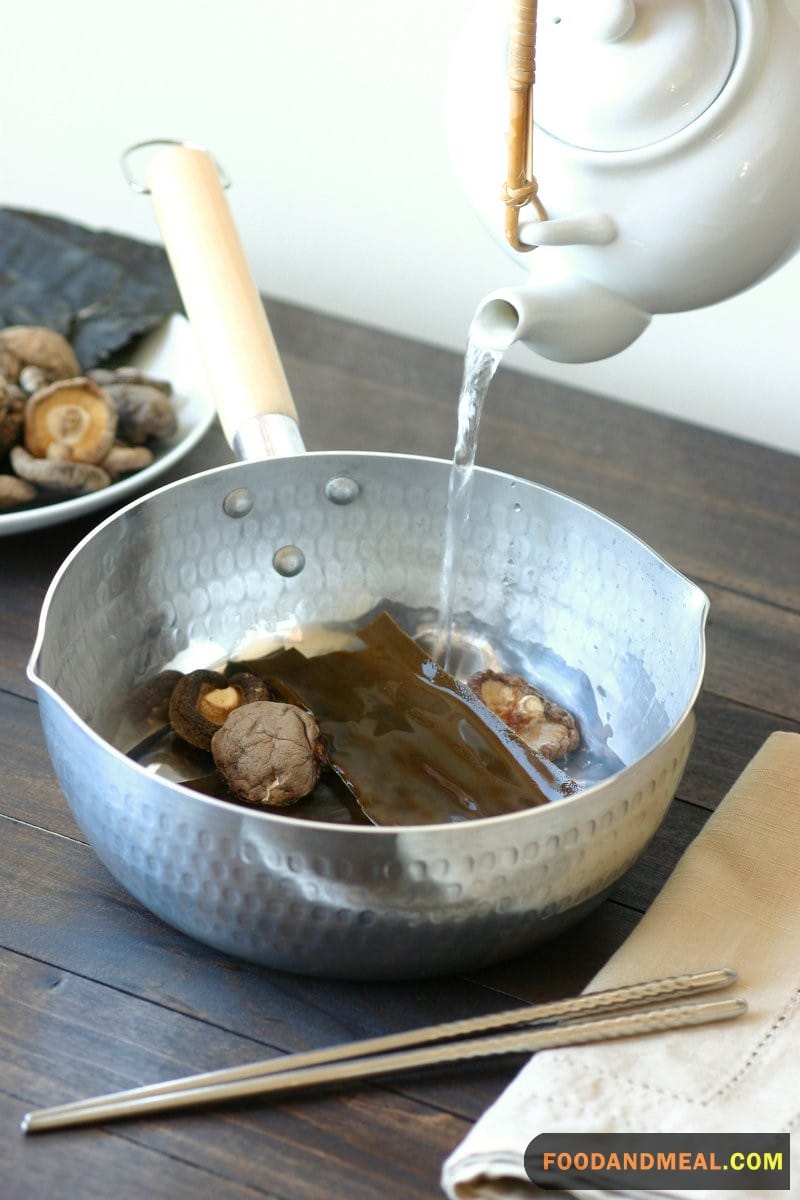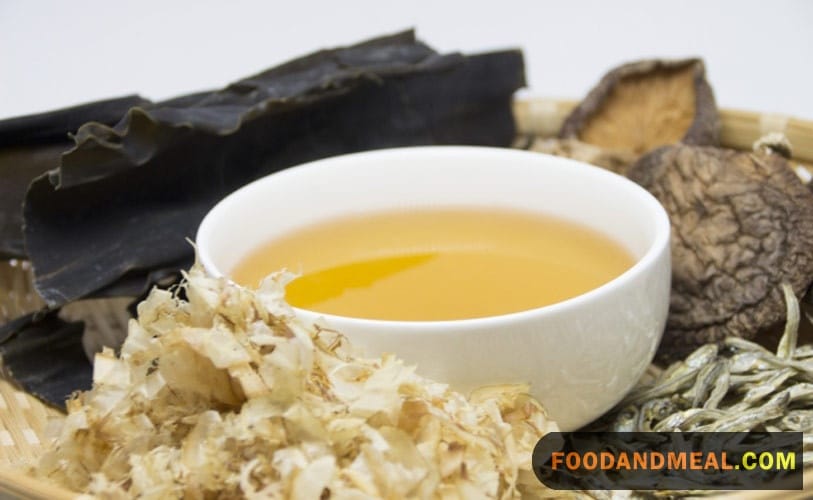If you’re unfamiliar with the basics of Japanese cooking, you should start with the basics of dashi (basic Japanese stock). This base is made from dried seaweed called awase dashi, and bonito flakes (salmon roe) and water. The classic method for preparing dashi is to steep post card-sized pieces of dried konbu in water overnight. The monks of Koya-san would then remove the dashi from the water and cook it with the rest of their fish, vegetables, and other ingredients.
Basic Japanese Stock – Dashi Recipes


Dashi - Japanese Stock
Equipment
Ingredients
- 14 x5 inch kelp kombu wiped clean but not washed
- 3 cups packed dried bonito flakes katsuobushi or dried and smoked skipjack tuna and sardine flakes
- 4-8 cups water depending on desired strength of flavor
Instructions
- Place the water in a pot or saucepan.
- Make a couple of slits on the kombu and soak it in the water for at least 30 minutes (although 3-8 hours is ideal).
- Gently bring it to a boil, skimming off any oil or scum.
- Remove the kombu just before water begins to boil. (Set it aside to make rice seasoning.)
- Turn off the heat and allow the water to cool.
- Add the bonito flakes and bring it to a boil again.
- Simmer for just 30 seconds, and turn off the heat. The flakes will sink to the bottom. Let it stand for 10 minutes.
- Line a sieve with a thick piece of paper towel and strain the broth, gently squeezing out the Dashi. (Keep the flakes for rice seasoning).
- Keeps for 1 week refrigerated or 3 weeks frozen.
Video
Notes
Nutrition
© Food And Meal
This website provides approximate nutrition information for convenience and as a courtesy only. Nutrition data is gathered primarily from the Spoonacular Database, whenever available, or otherwise other online calculators.
Alternative Method: Basic Japanese Stock in a Slow Cooker

Ingredients:
- 4 dried shiitake mushrooms
- 1 large onion, roughly chopped
- 1 large carrot, roughly chopped
- 2 celery stalks, roughly chopped
- 4 garlic cloves, crushed
- 6 cups cold water
- 2 tablespoons soy sauce
- 1-inch piece of kombu (dried kelp)
Instructions:
- Prep Your Slow Cooker: Begin by placing the dried shiitake mushrooms in a bowl and covering them with warm water. Allow them to soak for 30 minutes to rehydrate.
- Combine Ingredients: In your slow cooker, add the rehydrated shiitake mushrooms (along with the soaking water), chopped onion, carrot, celery, and crushed garlic cloves.
- Add the Kombu and Water: Place the piece of kombu into the slow cooker. Pour in the cold water, ensuring that all the ingredients are submerged.
- Set to Low Heat: Cover your slow cooker and set it to the low heat setting. Let the stock simmer gently for about 6-8 hours. This extended cooking time allows the flavors to fully infuse.
- Stir in Soy Sauce: About 30 minutes before the end of the cooking time, stir in the soy sauce to enhance the umami notes of the stock.
- Strain and Cool: Once the cooking time is complete, carefully strain the stock through a fine-mesh sieve or cheesecloth into a large bowl. Allow it to cool to room temperature.
- Store or Use: You can use your Basic Japanese Stock immediately in your favorite Japanese dishes, or let it cool further and then store it in airtight containers in the refrigerator or freezer.
Tips for making Basic Japanese Stock

Serving Suggestions
Recommended Sides and Garnishes:
- Miso Soup: A classic pairing, the umami-rich Basic Japanese Stock is the perfect base for a hearty miso soup. Add tofu, seaweed, and green onions for the complete experience.
- Ramen: Transform your stock into a delightful ramen broth. Cook ramen noodles separately, then ladle the piping hot stock over them. Top with soft-boiled eggs, sliced pork, and bok choy for an authentic ramen experience.
- Udon Soup: For a slightly different twist, use your stock to create a delicious udon soup. Add thick udon noodles, shiitake mushrooms, and spinach for a satisfying meal.
- Sukiyaki: Explore the world of sukiyaki by simmering thin slices of beef, tofu, and vegetables in your stock. Dip the cooked ingredients into raw beaten egg before devouring.
- Chawanmushi: This savory Japanese egg custard is a delicacy. Use your stock as a base and add ingredients like shrimp, mushrooms, and ginkgo nuts for a unique appetizer.
Beverage Pairings:
- Green Tea: Keep it classic with a soothing cup of green tea to complement the umami flavors of your Japanese stock.
- Sake: For an authentic Japanese experience, pair your dish with a good quality sake. The delicate flavors of sake harmonize beautifully with the stock.
- Light Beer: If you prefer beer, opt for a light Japanese lager. Its crispness and effervescence can contrast the richness of the stock nicely.
Cooking Tips

- Quality Ingredients: The quality of your ingredients matters. Use fresh vegetables and high-quality dried shiitake mushrooms for the best flavor.
- Simmer Slowly: Patience is the key to a rich and flavorful stock. Allow the ingredients to simmer gently over low heat to extract maximum flavor without boiling.
- Store for Future Creations: Basic Japanese Stock freezes beautifully. Consider making a larger batch and storing it in smaller portions in the freezer. It’s a versatile foundation for future Japanese dishes.
- Don’t Rush the Straining: When straining your stock, don’t rush it. Allow it to flow through a fine-mesh sieve or cheesecloth naturally, without pressing or squeezing the solids, to keep the stock clear.
- Reheat Gently: If you’re reheating your stock, do it gently over low heat. Avoid boiling it, as this can affect the flavor and texture. Reheating on low to medium heat is ideal.
FAQs about Basic Japanese Stock

- Can I store leftover Basic Japanese Stock? Absolutely! Store any leftover stock in airtight containers in the refrigerator. It can be kept for 3-4 days. To store it for a longer duration, freeze the stock in smaller portions and thaw as needed.
- Can I make a vegetarian version of this stock? Certainly! Omit the dried shiitake mushrooms and use more kombu and additional vegetables like cabbage and daikon for a flavorful vegetarian stock.
- How can I intensify the umami flavor of the stock? You can enhance the umami notes by adding a small handful of bonito flakes (katsuobushi) while simmering the stock. This adds an extra layer of depth to the flavor.
- Is there a specific soy sauce to use for the stock? Traditionally, Japanese soy sauce (shoyu) is preferred, but you can use any high-quality soy sauce. If you have dark soy sauce, use it sparingly as it can darken the stock significantly.
- Can I reuse the solids after straining the stock? While you can reuse the vegetables and kombu, they are often quite flavorless after simmering for so long. It’s better to compost them or discard them after straining.
Master the art of Basic Japanese Stock, the cornerstone of Japanese cuisine. Share this umami-rich recipe and subscribe for more culinary inspiration.
I'm James F Anderson, a noted sous chef from London and a Le Cordon Bleu alumnus. My career began in a Michelin-starred Parisian eatery, where my blend of classic and contemporary cooking, using seasonal ingredients, earned accolades. Recognized in culinary publications and on cooking shows, I’m committed to mentoring aspiring chefs and delivering memorable dining experiences, marking me as a standout talent in the culinary world.

